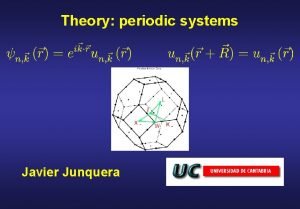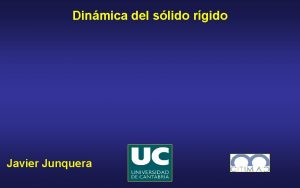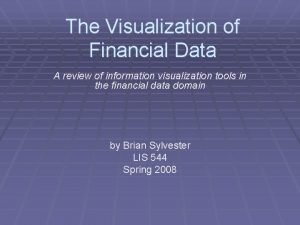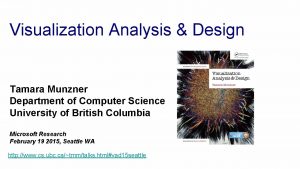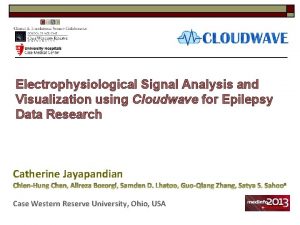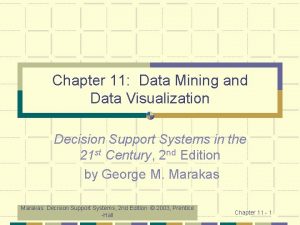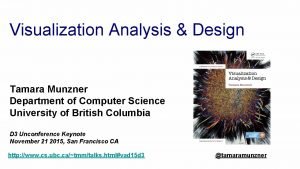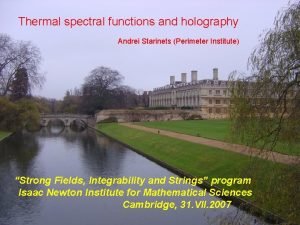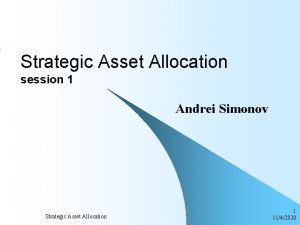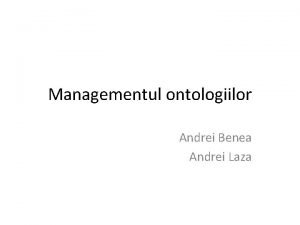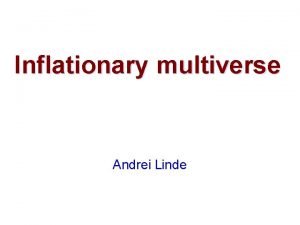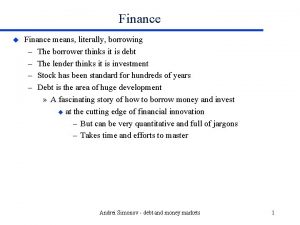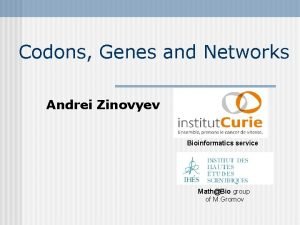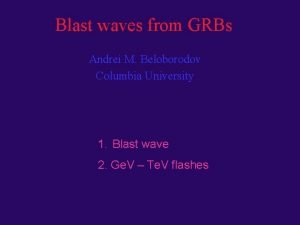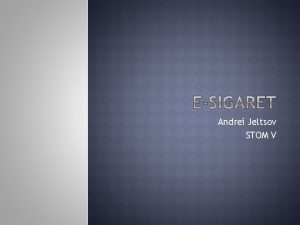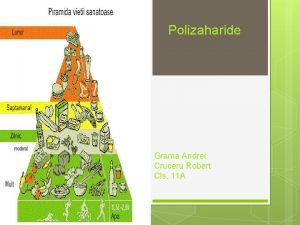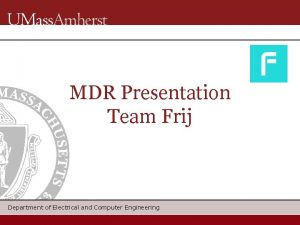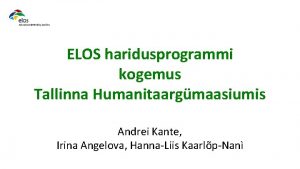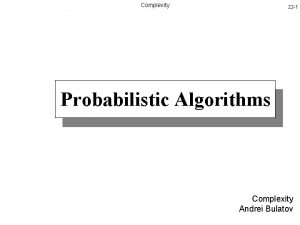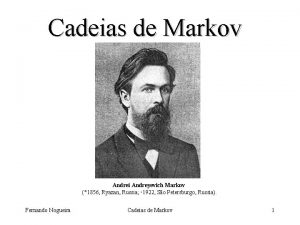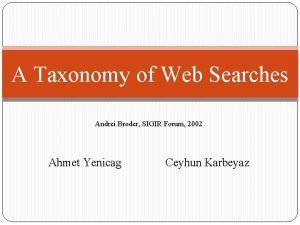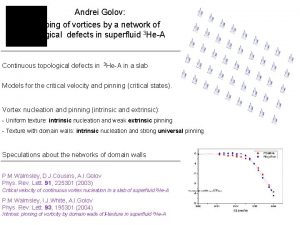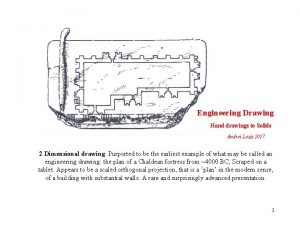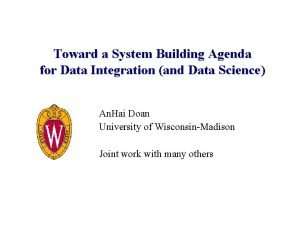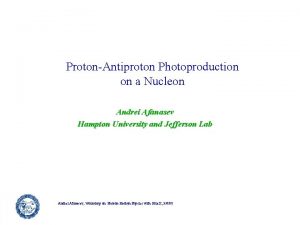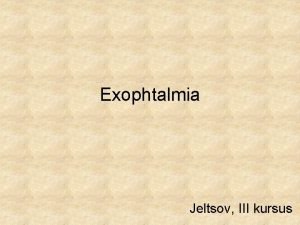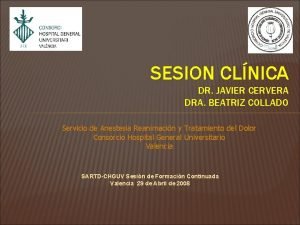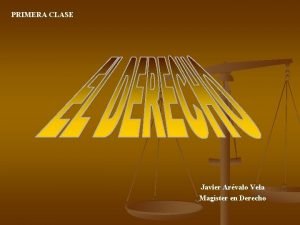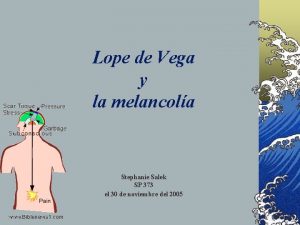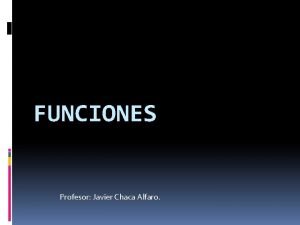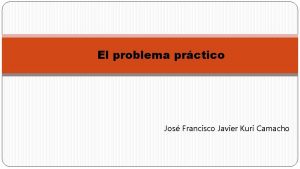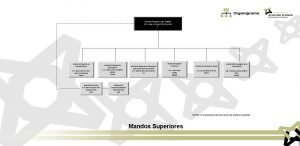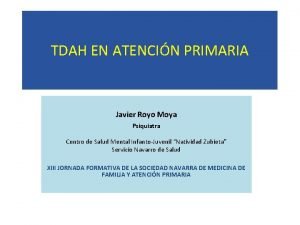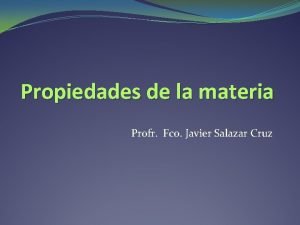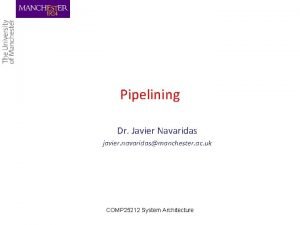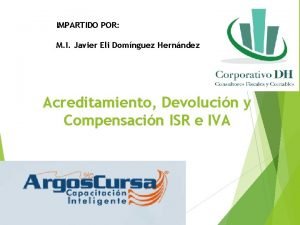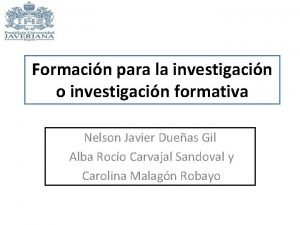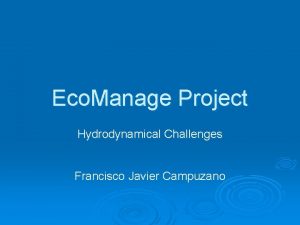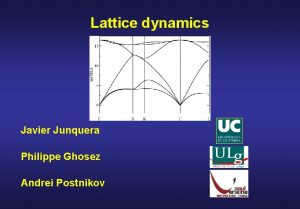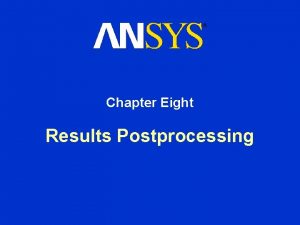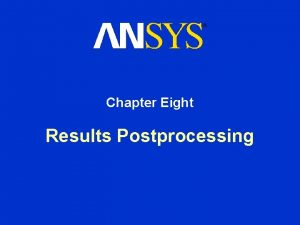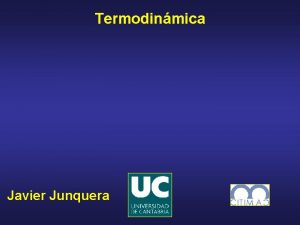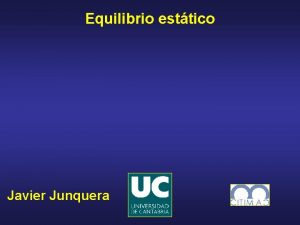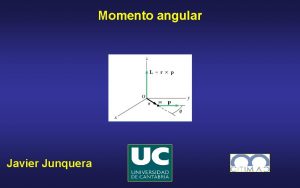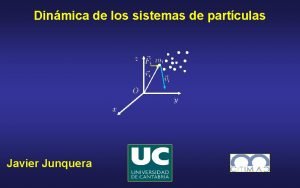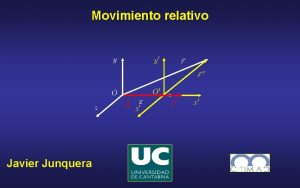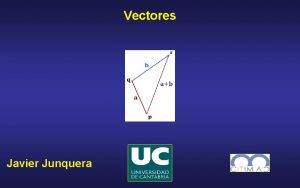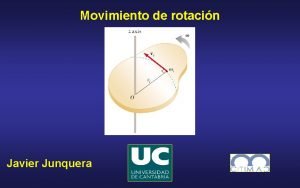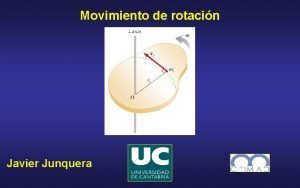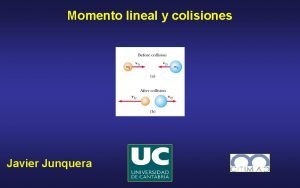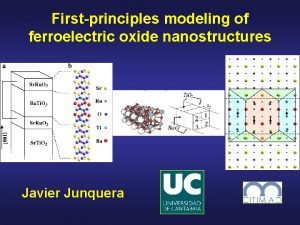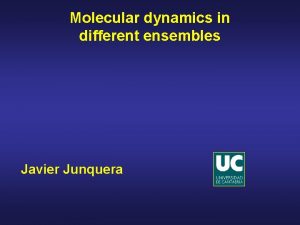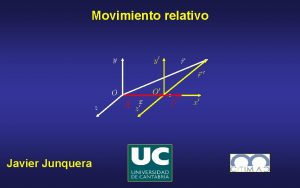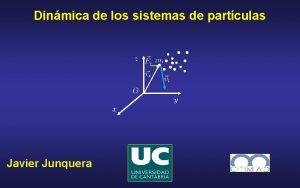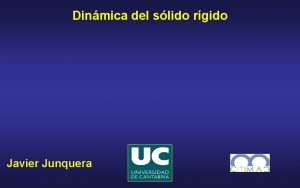Analysis postprocessing and visualization tools Javier Junquera Andrei





























































- Slides: 61

Analysis, post-processing and visualization tools Javier Junquera Andrei Postnikov

Summary of different tools for -processing and visualization DENCHAR PLRHO post DOS, PDOS and PDOS total Fe, d MACROAVE SIESTA’s output with XCRYSDEN

Summary of different tools for -processing and visualization DENCHAR PLRHO post DOS, PDOS and PDOS total Fe, d MACROAVE SIESTA’s output with XCRYSDEN

DENCHAR plots the charge density and wave functions in real space Wave functions Coefficients of the eigenvector with eigenvalue Charge density matrix atomic orbitals

DENCHAR operates in two different modes: 2 D and 3 D 2 D • Charge density and/or electronic wave functions are printed on a regular grid of points contained in a 2 D plane specified by the user. • Used to plot contour maps by means of 2 D graphics packages. 3 D • Charge density and/or electronic wave functions are printed on a regular grid of points in 3 D. • Results printed in Gaussian Cube format. • Can be visualized by means of standard programs (Moldel, Molekel, Xcrysden)

How to compile DENCHAR… Use the same arch. make file as for the compilation of serial SIESTA Versions before 2. 0. 1, please check for patches in http: //fisica. ehu. es/ag/siesta-extra/issues. html …and where to find the User’s Guide and some Examples

How to run DENCHAR… SIESTA Write. Denchar Write. Wave. Functions %block Wave. Func. KPoints 0. 0 %endblock Wave. Func. KPoints . true. Only if you want to plot wave functions Output of SIESTA required by DENCHAR System. Label. PLD System. Label. DIM System. Label. DM System. Label. WFS (only if wave functions) Chemical. Species. ion (one for each chemical species) DENCHAR $ ln –s ~/siesta/Src/denchar. $ denchar < dencharinput. fdf You do not need to rerun SIESTA to run DENCHAR as many times as you want

Input of DENCHAR General issues • Written in fdf (Flexible Data Format), as in SIESTA • It shares some input variables with SIESTA System. Label Number. Of. Species Chemical. Species. Label • Some other input variables are specific of DENCHAR (all of them start with “Denchar. ”) To specify the mode of usage To define the plane or 3 D grid where the charge/wave functions are plotted To specify the units of the input/output • Input of DENCHAR can be attached at the end of the input file of SIESTA

Input of DENCHAR How to specify the mode of run • Denchar. Type. Of. Run (string) 2 D or 3 D • Denchar. Plot. Charge (logical) . TRUE. or. FALSE. If. true. System. Label. DM must be present • Denchar. Plot. Wave. Functions (logical) . TRUE. or. FALSE. If. true. System. Label. WFS must be present Either one or the other (or both of them) must be. true.

Input of DENCHAR How to specify the plane • Denchar. Plane. Generation Plane of the plot in 2 D mode x-y plane in 3 D mode (string) Normal. Vector Two. Lines Three. Points Three. Atomic. Indices + more variables to define the generation object (the normal vector, lines, points or atoms) origin of the plane x-axis size of the plane number of points in the grid • Different variables described in the User Guide (take a look to the Examples)

Output of DENCHAR 2 D mode Charge density Spin unpolarized: self-consistent charge (. CON. SCF) deformation charge (. CON. DEL) Spin polarized: Wave functions Wave function for different bands (each wavefunction in a different file). CON. WF#, where # is the number of the wf (If spin polarized, suffix. UP or. DOWN) density spin up (. CON. UP) density spin down (. CON. DOWN) deformation charge (. CON. DEL) magnetization (. CON. MAG) Format

Output of DENCHAR 3 D mode Charge density Wave functions Spin unpolarized: Wave function for different bands self-consistent charge (. RHO. cube) deformation charge (. DRHO. cube) Spin polarized: (each wavefunction in a different file). WF#. cube, where # is the number of the wf (If spin polarized, suffix. UP or. DOWN) density spin up (. RHO. UP. cube) density spin down (. RHO. DOWN. cube) deformation charge (. DRHO. cube) Format Gaussian Cube format Atomic coordinates and grid points in the reference frame given in the input Reference frame orthogonal

Summary of different tools for -processing and visualization DENCHAR PLRHO post DOS, PDOS and PDOS total Fe, d MACROAVE SIESTA’s output with XCRYSDEN

PLRHO plots a 3 D isosurface of the charge density and colours it with a second function • • LDOS integrated in a given energy interval • + electrostatic potential • + total potential • + spin density Plrho reads the values of the functions in the real space grid and Interpolates to plot the 3 D surface.

How to compile PLRHO • First you need to install the PGPLOT library, available from http: //www. astro. caltech. edu/~tjp/pgplot • You can find plrho at ~/siesta/Utils/Plrho • Then compile PLRHO with $ f 90 plrho. f –l. X 11 –lpgplot –o plrho • Check plrho_guide. txt for extra information.

How to run PLRHO SIESTA Save. Rho. true. Save. Electrostatic. Potential. true. Save. Total. Potential. true. %block Local. Density. Of. States %block Atomic. Coordinates. Origin Depending on what you want to plot If you want to center the system Output of SIESTA required by PLRHO System. Label. VH System. Label. VT System. Label. LDOS PLRHO Prepare the input file plrho. dat $ plrho You do not need to rerun SIESTA to run PLRHO as many times as you want

Input of PLRHO: plrho. dat

Input of PLRHO: plrho. dat ‘rho’ ‘ldos’ LDOS integrated in a given energy interval ‘vh’ + electrostatic potential ‘vt’ + total potential ‘spin’ + spin density

Input of PLRHO: plrho. dat Viewpoint is always from above (positive z axis) y z x To view the system from a different angle, rotate it with the Euler angles

Input of PLRHO: plrho. dat Example: view from –y (Euler angles = 90 -90) y z z x y x

Input of PLRHO: plrho. dat Example: view from –y (Euler angles = 90 -90) Reference axes System axes y z y x z x

Input of PLRHO: plrho. dat Example: view from –y (Euler angles = 90 -90) Reference axes System axes y z y x z x x y z Alpha: first rotation around z

Input of PLRHO: plrho. dat Example: view from –y (Euler angles = 90 -90) Reference axes System axes y z y x z x x y x z z y Beta: rotation around y

Input of PLRHO: plrho. dat Example: view from –y (Euler angles = 90 -90) Reference axes System axes y z y x z x x y x z z z y y x Gamma: second rotation around z

Input of PLRHO: plrho. dat

Input of PLRHO: plrho. dat Value of colouring function Potential or Spin Pure blue Third value: maximum saturation range blue Interpolation white/blue Second value: mean saturation range white Interpolation red/white First value: minimum saturation range red Pure red

Output of PLRHO screen grey-scale postscrip colour postscrip

Output of PLRHO H 2 O molecule

Summary of different tools for -processing and visualization DENCHAR PLRHO post DOS, PDOS and PDOS total Fe, d MACROAVE SIESTA’s output with XCRYSDEN

Density Of States (DOS) the number of one-electron levels between E and E + d. E Si bulk

Density Of States (DOS) the number of one-electron levels between E and E + d. E Si bulk Units: (Energy)-1

Projected Density Of States (PDOS) the number of one-electron levels with weight on orbital between E and E + d. E Coefficients of the eigenvector Overlap matrix of the atomic basis with eigenvalue Units: (Energy)-1 Relation between the DOS and PDOS:

The eigenvalues are broadening by a gaussian to smooth the shape of the DOS and PDOS related with the FWHM

Two step procedure to produce smooth DOS and PDOS First: Run a simulation with a sensible (converged) number of k-points kgrid_cutoff %block kgrid_Monkhorst_Pack Get converged geometry and density matrix Second: Starting from the previously converged geometry and density matrix, run a single SCF step with fixed geometry, with many more k-points DM. Use. Save. DM . true. Max. SCFIterations 1 MD. Num. CGsteps (or equivalent) 0 Increase number of k-points (see above) %block Projected. Density. Of. States

How to compute the DOS and PDOS %block Projected. Density. Of. States -20. 0 10. 0 0. 200 500 e. V %endblock Projected. Density. Of. States -20. 0 10. 0 : Energy window where the DOS and PDOS will be computed

How to compute the DOS and PDOS %block Projected. Density. Of. States -20. 0 10. 0 0. 200 500 e. V %endblock Projected. Density. Of. States -20. 0 10. 0 : Energy window where the DOS and PDOS will be computed 0. 200 : Peak width of the gaussian used to broad the eigenvalues (energy)

How to compute the DOS and PDOS %block Projected. Density. Of. States -20. 0 10. 0 0. 200 500 e. V %endblock Projected. Density. Of. States -20. 0 10. 0 : Energy window where the DOS and PDOS will be computed 0. 200 : Peak width of the gaussian used to broad the eigenvalues (energy) 500 : Number of points in the histogram

How to compute the DOS and PDOS %block Projected. Density. Of. States -20. 0 10. 0 0. 200 500 e. V %endblock Projected. Density. Of. States -20. 0 10. 0 : Energy window where the DOS and PDOS will be computed 0. 200 : Peak width of the gaussian used to broad the eigenvalues (energy) 500 : Number of points in the histogram e. V : Units in which the previous energies are introduced

Output for the Density Of States System. Label. DOS Format Energy (e. V) DOS Spin Up (e. V-1) DOS Spin Down (e. V-1)

Output for the Projected Density Of States System. Label. PDOS Written in XML Energy Window One element <orbital> for every atomic orbital in the basis set

How to digest the System. Label. PDOS file During the compilation of SIESTA For some compilers, the libwxml. a library needs to be compiled with “-DWXML_INIT_FIX” (see known issues in http: //fisica. ehu. es/ag/siesta-extra/issues. html) pdosxml (by Alberto García) Siesta/Util/pdosxml Edit the readme file to: Learn how to select the orbitals whose PDOS will be accumulated How to compile the code How to run the code fmpdos (by Andrei Postnikov) Download from http: //www. home. uni-osnabrueck. de/apostnik/download. html Compile and follow the instructions at run-time

Normalization of the DOS and PDOS Number of bands per k-point Number of atomic orbitals in the unit cell Number of electrons in the unit cell Occupation factor at energy E

Example of DOS and PDOS total Fe, d J. Junquera et al. Surf. Sci. 482 -485, 625 (2001) K. A. Mäder et al. Phys. Rev. B 48, 4364 (1998) SIESTA, single-zeta polarized basis All electron calculation

Summary of different tools for -processing and visualization DENCHAR PLRHO post DOS, PDOS and PDOS total Fe, d MACROAVE SIESTA’s output with XCRYSDEN

How to extract from the immense detail provided by firstprinciples calculations on surfaces reliable values of the physical quantities of interest

Physical quantities of interest in surfaces and interfaces • Charge densities at the surface/interface • Dipole moment densities at the surface/interface • Work functions (surfaces) and band offsets (interfaces) : the band structure term Difference of the top of the valence bands From two independent bulk band structure calculations of the bulk material : jump of the average electrostatic potential Contains all the intrinsic interface effects <VA> <VB> Obtained by nanosmoothing the electrostatic potential

First step: average in the plane vacuum Ba. Ti. O 3 vacuum

Second step: nanosmooth the planar average on the z-direction vacuum Ba. Ti. O 3 vacuum

Atomic scale fluctuations are washed out by filtering the magnitudes via convolution with smooth functions

is readily obtained from the nanosmoothed potential vacuum Ba. Ti. O 3 vacuum

How to compile MACROAVE… Use the same arch. make file as for the compilation of serial SIESTA …and where to find the User’s Guide and some Examples

How to run MACROAVE SIESTA Save. Rho Save. Total. Charge Save. Ionic. Charge Save. Delta. Rho Save. Electrostatic. Potential Save. Total. Potential . true. Depending on what you want to nanosmooth Output of SIESTA required by MACROAVE System. Label. RHO System. Label. TOCH System. Label. IOCH System. Label. DRHO System. Label. VH System. Label. VT MACROAVE Prepare the input file macroave. in $ ~/siesta/Util/Macroave/Src/macroave. x You do not need to rerun SIESTA to run MACROAVE as many times as you want

Input of MACROAVE: macroave. in The same code with the same input runs with information provided by Siesta or Abinit (indeed it should be quite straight forward to generalize to any other code)

Input of MACROAVE: macroave. in Name of the magnitude that will be nanosmoothed Potential: System. Label. VH Charge: System. Label. RHO Total. Charge: System. Label. TOCH

Input of MACROAVE: macroave. in System. Label

Input of MACROAVE: macroave. in Number of square filter functions used for nanosmoothing 1 Surfaces 2 Interfaces and superlattices

Input of MACROAVE: macroave. in Length of the different square filter functions (in bohrs)

Input of MACROAVE: macroave. in Total number of electrons (used only to renormalize if we nanosmooth the electronic charge)

Input of MACROAVE: macroave. in Type of interpolation from the SIESTA mesh to a FFT mesh Spline or Linear

Output of MACROAVE Planar average Nanosmoothed System. Label. PAV System. Label. MAV Format Units Coordinates: bohr Potential: e. V Charge density: electrons/bohr 3

To learn more on nanosmoothing and how to compute work functions and band offsets with SIESTA
 Javier junquera
Javier junquera The hamiltonian operator is given by
The hamiltonian operator is given by Javier junquera
Javier junquera Spotfire demo gallery
Spotfire demo gallery Tamara munzner
Tamara munzner Signal analysis and visualization
Signal analysis and visualization Define structured analysis
Define structured analysis Market basket analysis visualization
Market basket analysis visualization Visualization analysis & design
Visualization analysis & design Rubkev
Rubkev Andrei starinets
Andrei starinets Andrei simonov
Andrei simonov Andrei jeltsov
Andrei jeltsov Andrei laza
Andrei laza Andrei linde multiverse
Andrei linde multiverse Yiled to worst
Yiled to worst Andrei zinovyev
Andrei zinovyev Smdep columbia
Smdep columbia Andrei jeltsov
Andrei jeltsov Polizaharide
Polizaharide Frij andrei
Frij andrei Andrei kante
Andrei kante La trinidad de andrei rublev
La trinidad de andrei rublev Non-deterministic algorithm
Non-deterministic algorithm Andrei andreyevich markov
Andrei andreyevich markov A taxonomy of web search
A taxonomy of web search Andrei barasch
Andrei barasch Andrei golov
Andrei golov Andrei broder
Andrei broder Andrei lozzi
Andrei lozzi Andrei lozzi
Andrei lozzi Characters of crime and punishment
Characters of crime and punishment Andrei nacu
Andrei nacu Charles andrei
Charles andrei Andrei fortennis
Andrei fortennis Andrei lopatenko
Andrei lopatenko Andrei afanasev
Andrei afanasev Andrei bulgakov
Andrei bulgakov Andrei jeltsov
Andrei jeltsov Evolutia omului
Evolutia omului Andrei vasilescu
Andrei vasilescu Andrei ionescu deloitte
Andrei ionescu deloitte Io andrei
Io andrei Javier arvalo
Javier arvalo Javier navaridas
Javier navaridas Javier remiro
Javier remiro Dr. javier collado
Dr. javier collado Arvalo
Arvalo Dr. javier e. calvo
Dr. javier e. calvo Javier salek
Javier salek Javier chaca
Javier chaca Dr. francisco javier kuri con
Dr. francisco javier kuri con Javier canillas
Javier canillas Francisco javier salazar silva
Francisco javier salazar silva Abu bakr al-baghdadi
Abu bakr al-baghdadi Josh gloria bustamante
Josh gloria bustamante Javier royo psiquiatra consulta
Javier royo psiquiatra consulta Porosidad inercia extensión
Porosidad inercia extensión Javier navaridas
Javier navaridas Javier eli dominguez hernandez
Javier eli dominguez hernandez Nelson javier duenas gil
Nelson javier duenas gil Dr javier campuzano
Dr javier campuzano
